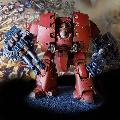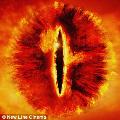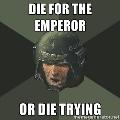| Author |
Message |
 |
|
|
 |
|
Advert
|
Forum adverts like this one are shown to any user who is not logged in. Join us by filling out a tiny 3 field form and you will get your own, free, dakka user account which gives a good range of benefits to you:
- No adverts like this in the forums anymore.
- Times and dates in your local timezone.
- Full tracking of what you have read so you can skip to your first unread post, easily see what has changed since you last logged in, and easily see what is new at a glance.
- Email notifications for threads you want to watch closely.
- Being a part of the oldest wargaming community on the net.
If you are already a member then feel free to login now. |
|
 |
![[Post New]](/s/i/i.gif) 2019/08/15 06:31:14
Subject: Mathhammer and reality
|
 |

Nihilistic Necron Lord
|
Here is something i dont really understand. Mathhammer says the chances are 1/36 for rolling two ones, when you roll one dice twice. But, in reality its 1/6 for the first time, and 1/6 the second time. The real chance of rolling another one is six times higher than mathhammer suggests. Why use mathhammer when its not close to reality ?
|
|
|
 |
 |
![[Post New]](/s/i/i.gif) 2019/08/15 06:37:00
Subject: Mathhammer and reality
|
 |

Longtime Dakkanaut
|
 p5freak wrote: p5freak wrote:Here is something i dont really understand. Mathhammer says the chances are 1/36 for rolling two ones, when you roll one dice twice. But, in reality its 1/6 for the first time, and 1/6 the second time. The real chance of rolling another one is six times higher than mathhammer suggests. Why use mathhammer when its not close to reality ?
Your error seems to be that you are assuming the roll of a 1 on the first dice as a given, and then only looking at the probability of the second roll.
That 1/36 chance is the probability of both getting a 1 on the first roll AND getting a 1 on the second roll.
|
|
|
 |
 |
![[Post New]](/s/i/i.gif) 2019/08/15 06:43:25
Subject: Mathhammer and reality
|
 |

Locked in the Tower of Amareo
|
Oh dear oh dear...Somebody not understanding how basic probabilities work...
Your odds of rolling two 1's is 1/36.
If you are looking at odds of rolling 1 after rolling 1 you aren't looking at odds of rolling 2 1's but one 1.
Not sure is OP even serious or is this just troll thread?
|
2024 painted/bought: 109/109 |
|
|
 |
 |
![[Post New]](/s/i/i.gif) 2019/08/15 06:53:02
Subject: Mathhammer and reality
|
 |

Longtime Dakkanaut
|
Out of respect for the OP, I'll assume this is a troll thread.
|
|
|
 |
 |
![[Post New]](/s/i/i.gif) 2019/08/15 07:07:24
Subject: Mathhammer and reality
|
 |

Malicious Mandrake
|
Here you go... (I'm bored, and waiting for something)
you can roll:
1,1 1,2 1,3 1,4 1,5 1,6
2,1 2,2 2,3 2,4 2,5 2,6
3,1 3,2 3,3 3,4 3,5 3,6
4,1 4,2 4,3 4,4 4,5 4,6
5,1 5,2 5,3 5,4 5,5 5,6
6,1 6,2 6,3 6,4 6,5 6,6
36 possible combinations. Only 1 of them is two 1s. 1/36
|
|
|
 |
 |
![[Post New]](/s/i/i.gif) 2019/08/15 07:26:18
Subject: Mathhammer and reality
|
 |

Horrific Hive Tyrant
|
It all depends at what point you are calculating the probability.
If you have already rolled a 6, then of course you have a 1/6 chance of rolling second 6. The first 6 doesn't factor into the calculation because it is fact at that point. It's probability is 1 - definite.
However you only had a 1/6 chance of rolling that first 6. There were another 5 equally likely (if it were a truly random roll) realities in which you didn't roll a 6.
It's basically a form of Gambler's Fallacy.
|
|
|
 |
 |
![[Post New]](/s/i/i.gif) 2019/08/15 07:35:59
Subject: Mathhammer and reality
|
 |

Willing Inquisitorial Excruciator
|
It’s like the above people say. Whilst you are correct that if you roll a 1 then it’s a 1/6 to roll another 1 the problem is rolling that first 1. If it helps you understand then think like this: it’s 1/6 and 1/6 to roll two ones. Since you roll the dice at the same time there’s as many outcomes as the possible dice times each other: 1/6X1/6.
Hence rolling two 6 sided dice means the following: 1/6X1/6=1x1/6x6=1/36
|
|
This message was edited 1 time. Last update was at 2019/08/15 07:36:25
His pattern of returning alive after being declared dead occurred often enough during Cain's career that the Munitorum made a special ruling that Ciaphas Cain is to never be considered dead, despite evidence to the contrary. |
|
|
 |
 |
![[Post New]](/s/i/i.gif) 2019/08/15 07:36:26
Subject: Re:Mathhammer and reality
|
 |

Nihilistic Necron Lord
|
Ok, i get it now.
|
|
|
 |
 |
![[Post New]](/s/i/i.gif) 2019/08/15 07:43:08
Subject: Mathhammer and reality
|
 |

Ridin' on a Snotling Pump Wagon
|
The bigger problem with Mathhammer is that it's only useful to a point, as it can't really account in-game oddities, such as terrain density, LoS, and your opponent having sneaky things to mess with the odds.
I mean, it has it's uses, of course it does. Even just looking at the BS difference between a Marine and an Ork, and concluding the Marine is, statistically, a better shot is Mathhammer, just as the statline clearly showing a Carnifex is tougher than a Tyranid Warrior is Mathhammer. When I was weighing up the relative reliability between the Twin Lightning Lock Moirax vs Twin Autocannon War Dog, I was Mathhammering (turns out there, the Lightning Locks exploding 6's and fixed 6 shots each tips the scales in their favour)
But I've always been left scratching my head at those who feel it will enable the writing of an unbeatable list, as such lists are written in a vacuum. They don't, and perhaps can't, allow for what you might face, the mission and objectives being played, amount and type of scenery etc.
|
|
This message was edited 1 time. Last update was at 2019/08/15 07:51:45
|
|
|
 |
 |
![[Post New]](/s/i/i.gif) 2019/08/15 08:07:19
Subject: Mathhammer and reality
|
 |

Regular Dakkanaut
|
Statistics on internet forum have free reign, but they have to face lady luck and miss.fortune on the field and it never wins.
|
|
|
 |
 |
![[Post New]](/s/i/i.gif) 2019/08/15 08:17:59
Subject: Mathhammer and reality
|
 |

Horrific Hive Tyrant
|
It's not that maths in wargames isn't extremely useful. Rather it's that interpreting statistics for practical use in a wargame is far more difficult that most people realise.
It isn't a case of X is bigger than Y, so take X. There's a lot more to consider. But crunching the number absolutely helps, with the proviso you use it properly.
|
|
This message was edited 1 time. Last update was at 2019/08/15 08:24:01
|
|
|
 |
 |
![[Post New]](/s/i/i.gif) 2019/08/15 08:21:07
Subject: Mathhammer and reality
|
 |

Longtime Dakkanaut
|
People also forget about variance as well.
Two different dice sets may have the same probability for certain results, but one may be weighted to be way more streaky than the other (more crushing successes or utter failures which average out to another that more or less give middling results most of the time).
|
hello |
|
|
 |
 |
![[Post New]](/s/i/i.gif) 2019/08/15 08:27:13
Subject: Mathhammer and reality
|
 |

Horrific Hive Tyrant
|
 Daba wrote: Daba wrote:People also forget about variance as well.
Two different dice sets may have the same probability for certain results, but one may be weighted to be way more streaky than the other (more crushing successes or utter failures which average out to another that more or less give middling results most of the time).
This is true. Flat 3 damage is often more desirable than d6, even though d6 averages out better.
People sometimes even fail to account for lost damage due to the wound characteristic of the intended target.
|
|
|
 |
 |
![[Post New]](/s/i/i.gif) 2019/08/15 08:41:17
Subject: Mathhammer and reality
|
 |

Decrepit Dakkanaut
UK
|
Mathhammer also has elements where you have to make guesses and estimations in order to calculate the odds when you're working without a game to base it off.
For example lets say you've two types of infantry and you want to work out which might be the better in a close combat fight.
1) You've got to make a guess as to how many units to put into the unit to calculate with
2) You've got to make a guess as to how many of those units make it into actual close combat. This might get more tricky if you've got two or three different weapons in the unit with different reaches.
A unit with a 2 inch reach on their weapon should, in reality, get more units into close combat than a unit with only a 1 inch weapon reach. So now do you put only 10 units of 30 man units into the front-line? Or 5?
This gets more tricky when you start comparing units with different base sizes against each other and if you're trying to simulate real battles etc...
Basically you have to define some variables in an ideal sense and understand that whilst you might see a pattern in the maths, you might not necessarily see it on the tabletop.
This can also be a bonus though because you can get a rough idea which unit is better in certain roles mathematically speaking. Now on the tabletop you might play several games with that unit where it never gets into a good formation position - perhaps its always strung out like a snake and thus never actually gets enough of its models into range/close combat in a single turn to do effective damage; or the enemy is able to chip away at it.
Maths gives you some baseline theory to work with and it can be great in working out the rough function of your army and how things stack up. It can help in making effective choices in the game as well as understand when you're taking a big risk on something. When an attack is more likely to fail than work before you've even rolled the dice. This can be a big boon because it means that you set your tactics up without false expectations. Of course luck isn't perfect so you can still lose on a very certain attack - we've all taken a unit that should win without trouble against an opponent and suddenly found the dice to all miss and the opponents to all hit and suddenly its all going to bits.
|
|
|
|
 |
 |
![[Post New]](/s/i/i.gif) 2019/08/15 08:46:47
Subject: Mathhammer and reality
|
 |

Resolute Ultramarine Honor Guard
|
 p5freak wrote: p5freak wrote:Here is something i dont really understand. Mathhammer says the chances are 1/36 for rolling two ones, when you roll one dice twice. But, in reality its 1/6 for the first time, and 1/6 the second time. The real chance of rolling another one is six times higher than mathhammer suggests. Why use mathhammer when its not close to reality ?
Because you’re not counting all the non-1’s on the first roll. Mathhammer isn’t a prediction, it’s a long term expectation. Mathhammer doesn’t predict you’ll roll double 1’s all turn long I. The third turn of your next game, it tells you how many games you’d have to play to have a decent chance for all your dice rolls on turn 3 to be 1’s. it tells you how well to expect a unit to perform over a thousand turns.
|
My WHFB armies were Bretonians and Tomb Kings. |
|
|
 |
 |
![[Post New]](/s/i/i.gif) 2019/08/15 09:13:34
Subject: Re:Mathhammer and reality
|
 |

Junior Officer with Laspistol
|
I also think what is often overlooked using mathhammer are things like weapon type (especially assault, which more or less ads the advance range) and range. The best example being that flamers always compare rather nicely, but in reality there is a non neglectable probability that the flamer can't shoot every turn due to it's limited range.
Another thing that is often overlooked using mathhammer is the range of possible targets. While it is clear that mathematically a missile launcher is worse at anti tank duty than a lascannon and worse at anti infantry than a heavy bolter it keeps some usefulness after the enemy runs out of the prefered target. And it has a chance of messing up target Preference.
Non the less it is a very nice tool to get some impression of the expected damage under certain model conditions (as Overread said)
|
|
This message was edited 1 time. Last update was at 2019/08/15 09:14:04
 ~7510 build and painted ~7510 build and painted
 1312 build and painted 1312 build and painted
 1200 1200 |
|
|
 |
 |
![[Post New]](/s/i/i.gif) 2019/08/15 11:59:05
Subject: Mathhammer and reality
|
 |

Longtime Dakkanaut
London
|
Mathhammer can be great - if you are good at maths...
As you have found with probability it is a little more complex than appear.
For example you have a 5+ save with a re-roll. An unmoddified save for you will therefore succeed 5/9ths of the time.
Different ways of working that out, for me I work out the chance of never saving (2/3 x 2/3) and subtract that from 1.
You also have your result spread. Most simply understood as if you roll a bucket of D6 your results will more likely be predictably average than if you roll 1D6. So say you roll 500 with every 4+ doing 1 damage. Your result is likely to be around 250. Now roll 1D6 and do 500 damage on 4+, that could equally be good or bad, all or nothing.
And that is just the maths before you consider how terrain comes into it, how a few models are more likely to all be in range than lots and so on...
|
|
|
 |
 |
![[Post New]](/s/i/i.gif) 2019/08/15 14:44:07
Subject: Mathhammer and reality
|
 |

Locked in the Tower of Amareo
|
Its very useful as an upper boundary. Terrain and los make results smaller typically.
|
|
|
 |
 |
![[Post New]](/s/i/i.gif) 2019/08/15 15:35:28
Subject: Mathhammer and reality
|
 |

Sinewy Scourge
|
Being good at probability is useful in game, if you practise enough to be fast at it. Practising on paper in a forum helps with that. I'm quick enough to be able to estimate rough odds and spread within a percent or two for most things I come across in game at a speed that doesn't slow down play. If I didn't use probability at work and do calculations for 40k for fun I wouldn't be. It's a useful skill but the first little while of learning it it won't be that great for you at table time. With practise it will win you games.
Most useful for estimating how much is overkill and how much is a risky success. If you would kill a unit on a crucial objective on average, but your odds are like 60% success 40% failure, then commit more to it, but at the same time don't overcommit. If you are at 98% odds to take it out, stop. Consider it dead and plan to use your other firepower elsewhere. Two targets that you can comfortably get to 60%, but only a little firepower left? Try to position it to hit both. If you don't know those odds you will tend to over or under commit alot of the time.
|
|
This message was edited 1 time. Last update was at 2019/08/15 15:38:52
|
|
|
 |
 |
![[Post New]](/s/i/i.gif) 2019/08/15 16:10:03
Subject: Mathhammer and reality
|
 |

Omnipotent Necron Overlord
|
Even if this is a troll thread. It's important to look at each step in a process of decision making. It's true that rolling 2 1s on 2 dice is 1/36 but the odds of anything on a d6 are only 1/6 and the rolls have nothing to do with each other. The odds of rolling a 1 don't go down if you already rolled one.
Automatically Appended Next Post:
Often overlooks factors for mathhammer are distributions and standard deviations. The average result only occurs about 30% of the time which is LESS than half the time. So averages can be deceptive. Also things like flat 2 weapons not being able to deal .76 damage in practice. It ether does 2 or 0. Plus a command point reroll on a damage roll is often better than shoot 6 more of the same weapon.
Automatically Appended Next Post:
Poker players make great 40k players. Because they understand the value of a long shot. If the price is right.
|
|
This message was edited 2 times. Last update was at 2019/08/15 16:14:08
If we fail to anticipate the unforeseen or expect the unexpected in a universe of infinite possibilities, we may find ourselves at the mercy of anyone or anything that cannot be programmed, categorized or easily referenced.
- Fox Mulder |
|
|
 |
 |
![[Post New]](/s/i/i.gif) 2019/08/15 16:15:56
Subject: Mathhammer and reality
|
 |

Douglas Bader
|
 Xenomancers wrote: Xenomancers wrote:Even if this is a troll thread. It's important to look at each step in a process of decision making. It's true that rolling 2 1s on 2 dice is 1/36 but the odds of anything on a d6 are only 1/6 and the rolls have nothing to do with each other. The odds of rolling a 1 don't go down if you already rolled one.
Err, what? You have to look at each step in the process of making a decision but there is no step involved between rolling the first 1 and the second 1. You don't roll a 1, make another decision based on probability, then re-roll the 1. You roll a D6 and if it's a 1 you immediately re-roll it, for total odds of having a 1 as your result after your decision being 1/36. IOW, you're rolling a single strange bell-curve-shaped die with a 1/36 chance of a 1. The fact that the second die has a 1/6 chance of rolling a 1 as part of resolving that combined pseudo-die is only relevant if you interrupt the process to make another decision (for example spending a CP to re-roll it instead of having a general re-roll ability). Automatically Appended Next Post: Pyroalchi wrote:While it is clear that mathematically a missile launcher is worse at anti tank duty than a lascannon and worse at anti infantry than a heavy bolter it keeps some usefulness after the enemy runs out of the prefered target. And it has a chance of messing up target Preference.
This is actually a case where pure math answers the question. Frag missiles are terrible and even under ideal circumstances are not that much better than just using a krak missile, so their value is effectively zero and a missile launcher is just a weaker version of a lascannon. The whole "missile launchers are versatile" argument is entirely from people who haven't bothered to understand the math.
|
|
This message was edited 1 time. Last update was at 2019/08/15 16:18:18
There is no such thing as a hobby without politics. "Leave politics at the door" is itself a political statement, an endorsement of the status quo and an attempt to silence dissenting voices. |
|
|
 |
 |
![[Post New]](/s/i/i.gif) 2019/08/15 22:55:06
Subject: Mathhammer and reality
|
 |

Quick-fingered Warlord Moderatus
|
Going to be honest, the amount of needless condescension toward the OP is only rivalled by the number of errors in describing how applied math actually works in this thread.
@Peregrine
Another fun one is how overrated invulnerable saves actually are when you look at the math and think through the use cases. (Everybody is planning for their infantry to be shot at by Lascannons, apparently)
|
|
This message was edited 1 time. Last update was at 2019/08/15 22:55:36
|
|
|
 |
 |
![[Post New]](/s/i/i.gif) 2019/08/15 23:11:34
Subject: Mathhammer and reality
|
 |

Longtime Dakkanaut
|
As I see it:
Stage 1 Mathahammer.
Take two units. Compare them shooting/assaulting something, and being shot/assaulted by something. In a like for like comparison usually - although not always - normal distribution/long term average is enough. At least if you are looking at something which is "good" and something which is "bad". (Which, due to GW trying this edition, is becoming less and less, but a year ago there were blatant examples, and so still exist.)
Stage 2 - as people have said - is when you start working out the variance.
A good example of this is something like a quad fusion coldstar. (The world has moved on, but cast your mind back 12-18 months).
On paper (stage 1 mathhammer) its got a reasonable average damage against a wide range of targets. In practice however, if you break down the numbers, you have about a 20-25% chance of doing 12+ wounds on a vehicle with a reasonable invul (so, most of the meta relevant ones) and a 25% to do exactly nothing. The remaining half the time it does a bit of damage, but probably not enough to kill a vehicle which is what you need to happen. Which means it isn't a good tournament piece, because you would expect to have a run of games where it does nothing/badly.
So as said, D6 damage weapons are a good example of this issue. You have games you won when you rolled a few 5s and 6s and killed all their heavy stuff turn 1. You also however remember those games where you couldn't roll higher than a 2, and so essentially did no damage at all. You might find (points depending) stacking some D2 stuff is better, as it doesn't have the same blowout results one way or the other.
|
|
|
 |
 |
![[Post New]](/s/i/i.gif) 2019/08/16 00:35:19
Subject: Re:Mathhammer and reality
|
 |

Longtime Dakkanaut
|
I find math hammer much more useful during an actual game vs theory hammer on the internet. Like others have pointed out 40k isn't played in a vacuum and there are many variables to take into account. It's still useful for figuring out on the fly how likely something is to happen.
|
|
|
 |
 |
![[Post New]](/s/i/i.gif) 2019/08/16 02:33:27
Subject: Mathhammer and reality
|
 |

Shadowy Grot Kommittee Memba
|
Also general FYI:
To calculate the odds of a re-roll, take the inverse of the number, then square it, and subtract from 1.
Example: reroll able 3+ to hit roll.
3+ = .666
Inverse of .666 = .333
.333×.333=.11
1-.11=.89
89% chance to hit when you have a 3+ rerollable.
You don't add the probabilities, as there's still a chance, however slim, that you might fail.
|
"Got you, Yugi! Your Rubric Marines can't fall back because I have declared the tertiary kaptaris ka'tah stance two, after the secondary dacatarai ka'tah last turn!"
"So you think, Kaiba! I declared my Thousand Sons the cult of Duplicity, which means all my psykers have access to the Sorcerous Facade power! Furthermore I will spend 8 Cabal Points to invoke Cabbalistic Focus, causing the rubrics to appear behind your custodes! The Vengeance for the Wronged and Sorcerous Fullisade stratagems along with the Malefic Maelstrom infernal pact evoked earlier in the command phase allows me to double their firepower, letting me wound on 2s and 3s!"
"you think it is you who has gotten me, yugi, but it is I who have gotten you! I declare the ever-vigilant stratagem to attack your rubrics with my custodes' ranged weapons, which with the new codex are now DAMAGE 2!!"
"...which leads you straight into my trap, Kaiba, you see I now declare the stratagem Implacable Automata, reducing all damage from your attacks by 1 and triggering my All is Dust special rule!" |
|
|
 |
 |
![[Post New]](/s/i/i.gif) 2019/08/16 05:57:44
Subject: Mathhammer and reality
|
 |

Resolute Ultramarine Honor Guard
|
 Suzuteo wrote: Suzuteo wrote:Going to be honest, the amount of needless condescension toward the OP is only rivalled by the number of errors in describing how applied math actually works in this thread.
@Peregrine
Another fun one is how overrated invulnerable saves actually are when you look at the math and think through the use cases. (Everybody is planning for their infantry to be shot at by Lascannons, apparently)
We're not applying the math. We're roughly defining the ballpark in a fog bank. Applied math will take a tape measure and measure the distance from home plate to the outfield fence. Mathhammer guestimates the distance to the fence and if a 5 year old, a 15 year old, Bryce Harper, or a juiced up Barry Bonds is more likely to hit one over that fence. Applied math will take video of the ball in flight and tell you many feet away from home plate the ball landed, or would have without the interference of the seating and fan catching the ball.
|
|
This message was edited 2 times. Last update was at 2019/08/16 05:59:30
My WHFB armies were Bretonians and Tomb Kings. |
|
|
 |
 |
![[Post New]](/s/i/i.gif) 2019/08/16 06:16:01
Subject: Mathhammer and reality
|
 |

Decrepit Dakkanaut
|
 Peregrine wrote: Peregrine wrote: Xenomancers wrote: Xenomancers wrote:Even if this is a troll thread. It's important to look at each step in a process of decision making. It's true that rolling 2 1s on 2 dice is 1/36 but the odds of anything on a d6 are only 1/6 and the rolls have nothing to do with each other. The odds of rolling a 1 don't go down if you already rolled one.
Err, what? You have to look at each step in the process of making a decision but there is no step involved between rolling the first 1 and the second 1. You don't roll a 1, make another decision based on probability, then re-roll the 1. You roll a D6 and if it's a 1 you immediately re-roll it, for total odds of having a 1 as your result after your decision being 1/36. IOW, you're rolling a single strange bell-curve-shaped die with a 1/36 chance of a 1. The fact that the second die has a 1/6 chance of rolling a 1 as part of resolving that combined pseudo-die is only relevant if you interrupt the process to make another decision (for example spending a CP to re-roll it instead of having a general re-roll ability).
Automatically Appended Next Post:
Pyroalchi wrote:While it is clear that mathematically a missile launcher is worse at anti tank duty than a lascannon and worse at anti infantry than a heavy bolter it keeps some usefulness after the enemy runs out of the prefered target. And it has a chance of messing up target Preference.
This is actually a case where pure math answers the question. Frag missiles are terrible and even under ideal circumstances are not that much better than just using a krak missile, so their value is effectively zero and a missile launcher is just a weaker version of a lascannon. The whole "missile launchers are versatile" argument is entirely from people who haven't bothered to understand the math.
As far as I recall, two Lascannons and two Heavy Bolters actually outperform 4 Missile Launchers against most targets, which is pretty damn pathetic.
|
CaptainStabby wrote:If Tyberos falls and needs to catch himself it's because the ground needed killing.
 jy2 wrote: jy2 wrote:BTW, I can't wait to run Double-D-thirsters! Man, just thinking about it gets me Khorney.
 vipoid wrote: vipoid wrote:Indeed - what sort of bastard would want to use their codex?
 MarsNZ wrote: MarsNZ wrote:ITT: SoB players upset that they're receiving the same condescending treatment that they've doled out in every CSM thread ever.
|
|
|
 |
 |
![[Post New]](/s/i/i.gif) 2019/08/16 06:18:38
Subject: Mathhammer and reality
|
 |

Ladies Love the Vibro-Cannon Operator
|
 p5freak wrote: p5freak wrote:Here is something i dont really understand. Mathhammer says the chances are 1/36 for rolling two ones, when you roll one dice twice. But, in reality its 1/6 for the first time, and 1/6 the second time. The real chance of rolling another one is six times higher than mathhammer suggests. Why use mathhammer when its not close to reality ?
Well, rolling 1 has probability 1/6.
Rolling two 1's has probability 1/36 = 1/6 * 1/6, since the rolling of one dice is independent of rolling the other.
This independence assumption leads to the multiplication * of the single probabilities.
|
Former moderator 40kOnline
Lanchester's square law - please obey in list building!
Illumini: "And thank you for not finishing your post with a " " I'm sorry, but after 7200 's that has to be the most annoying sign-off ever." " I'm sorry, but after 7200 's that has to be the most annoying sign-off ever." 
Armies: Eldar, Necrons, Blood Angels, Grey Knights; World Eaters (30k); Bloodbound; Cryx, Circle, Cyriss |
|
|
 |
 |
![[Post New]](/s/i/i.gif) 2019/08/16 08:34:13
Subject: Re:Mathhammer and reality
|
 |

Junior Officer with Laspistol
|
Argg..... my laptop erased my whole long post... okay I try again *sigh*
@ Peregrin: Yes I understand what you are saying, but as I'm also no stranger to statistic I would like to explain my reasoning. If we compare Frag and Krak (or Lascannon, doesn't matter in this situation) on a BS4+ platform against GEQ, mathhamer will tell us the average number of unsaved wounds to be 0.778 (frag and 0.417 (Krak/Lascannon), yet the number of killed models is for some reason listed as being 1 for the Krak which is wrong (it should be 0.417 because damage does not spill). Furthermore we can note that the Krak will never kill more than one model per shot.
If we further look at the probability of hitting exactly 0/1/2/3/4/5/6 times with the Frag we get:
0 hits: 16.41%
1 hit: 31.25%
2 hits: 25.78%
3 hits: 16.67%
4 hits: 7.55%
5 hits: 2.08%
6 hits: 0.26%
which transforms to the following probabilities for killed GEQs:
0: 62.84%
1: 13.89%
2: 11.46%
3: 7.41%
4: 3.36%
5: 0.93%
6: 0.12%
While the Krak has:
0: 58.33%
1: 41.67%
What can we learn from that? While the average damage does not differ much, the Frag has a 23.26% Chance to kill at least two models and a 11.81% chance to kill at least 3. The Krak/Lascannon has 0% chance to kill more than one model. And I think this is an example for weapon differences, that is often overlooked using mathhamer
@Slayer-Fan 123: I have not calculated the Odds, but it can be possible that this is so, as long as all weapons stay on the table and have line of sight.
What I mean is: Lets say I run only tanks and face either 4 ML or 2 HB + 2LC. I have enough firepower to destroy 2 heavy weapons on my turn. In the latter case I would of course kill the lascannons and then only face HB. In the former case, while I can kill of two ML, the other two can still try to pop my tanks.
Or on a similar note due to LOS blocking terrain or models it might happen, that the "wrong" selection of the 2HB/2LC are facing a target or that the heavy bolters shorter range prevents them from reaching a infantry target, the frag missiles could hit, since it is not given, that like in mathhamer all weapons can fire all the time at every target they like.
|
|
This message was edited 1 time. Last update was at 2019/08/16 08:35:00
 ~7510 build and painted ~7510 build and painted
 1312 build and painted 1312 build and painted
 1200 1200 |
|
|
 |
 |
![[Post New]](/s/i/i.gif) 2019/08/16 09:23:16
Subject: Mathhammer and reality
|
 |

Resolute Ultramarine Honor Guard
|
the_scotsman wrote:Also general FYI:
To calculate the odds of a re-roll, take the inverse of the number, then square it, and subtract from 1.
Example: reroll able 3+ to hit roll.
3+ = .666
Inverse of .666 = .333
.333×.333=.11
1-.11=.89
89% chance to hit when you have a 3+ rerollable.
You don't add the probabilities, as there's still a chance, however slim, that you might fail.
That's the shortcut, the way to do it so you understand what you're figuring out - Find your normal success chance (67% - this is already in the bag) and add your failure rate (You only reroll your failures) * your success chance (The rerolls that will succeed) - i.e. if you hit on 3's (67%) you fail on 1's and 2's 33% so add 33% of 67% (13%) to 67%.(89%)
|
My WHFB armies were Bretonians and Tomb Kings. |
|
|
 |
 |
|
|